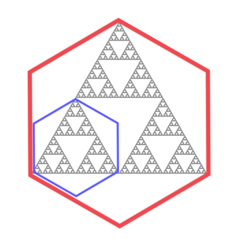Open set condition

In fractal geometry, the open set condition (OSC) is a commonly imposed condition on self-similar fractals. In some sense, the condition imposes restrictions on the overlap in a fractal construction.[1] Specifically, given an iterated function system of contractive mappings , the open set condition requires that there exists a nonempty, open set V satisfying two conditions:
- The sets are pairwise disjoint.
Introduced in 1946 by P.A.P Moran,[2] the open set condition is used to compute the dimensions of certain self-similar fractals, notably the Sierpinski Gasket. It is also used to simplify computation of the packing measure.[3]
An equivalent statement of the open set condition is to require that the s-dimensional Hausdorff measure of the set is greater than zero.[4]
Computing Hausdorff dimension
When the open set condition holds and each is a similitude (that is, a composition of an isometry and a dilation around some point), then the unique fixed point of is a set whose Hausdorff dimension is the unique solution for s of the following:[5]
where ri is the magnitude of the dilation of the similitude.
With this theorem, the Hausdorff dimension of the Sierpinski gasket can be calculated. Consider three non-collinear points a1, a2, a3 in the plane R2 and let be the dilation of ratio 1/2 around ai. The unique non-empty fixed point of the corresponding mapping is a Sierpinski gasket, and the dimension s is the unique solution of
Taking natural logarithms of both sides of the above equation, we can solve for s, that is: s = ln(3)/ln(2). The Sierpinski gasket is self-similar and satisfies the OSC.
Strong open set condition
The strong open set condition (SOSC) is an extension of the open set condition. A fractal F satisfies the SOSC if, in addition to satisfying the OSC, the intersection between F and the open set V is nonempty.[6] The two conditions are equivalent for self-similar and self-conformal sets, but not for certain classes of other sets, such as function systems with infinite mappings and in non-euclidean metric spaces.[7][8] In these cases, SOCS is indeed a stronger condition.
See also
References
- ↑ Bandt, Christoph; Viet Hung, Nguyen; Rao, Hui (2006). "On the Open Set Condition for Self-Similar Fractals". Proceedings of the American Mathematical Society 134 (5): 1369–74. http://www.jstor.org/stable/4097989.
- ↑ Moran, P.A.P. (1946). "Additive Functions of Intervals and Hausdorff Measure". Proceedings of the Cambridge Philosophical Society 42: 15-23. doi:10.1017/S0305004100022684.
- ↑ Llorente, Marta; Mera, M. Eugenia; Moran, Manuel. "On the Packing Measure of the Sierpinski Gasket". University of Madrid. https://eprints.ucm.es/id/eprint/58898/1/version%20final(previa%20prueba%20imprenta).pdf.
- ↑ Wen, Zhi-ying. "Open set condition for self-similar structure". Tsinghua University. https://www.math.cuhk.edu.hk/conference/afrt2012/slides/Wen_Zhiying.pdf.
- ↑ Hutchinson, John E. (1981). "Fractals and self similarity". Indiana Univ. Math. J. 30 (5): 713–747. doi:10.1512/iumj.1981.30.30055.
- ↑ Lalley, Steven (21 January 1988). "The Packing and Covering Functions for Some Self-similar Fractals". Purdue University. http://www.stat.uchicago.edu/~lalley/Papers/packing.pdf.
- ↑ Käenmäki, Antti; Vilppolainen, Markku. "Separation Conditions on Controlled Moran Constructions". http://users.jyu.fi/~antakae/publications/preprints/009-controlled_moran.pdf.
- ↑ Schief, Andreas (1996). "Self-similar Sets in Complete Metric Spaces". Proceedings of the American Mathematical Society 124 (2). https://www.ams.org/journals/proc/1996-124-02/S0002-9939-96-03158-9/S0002-9939-96-03158-9.pdf.
 |
